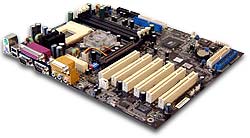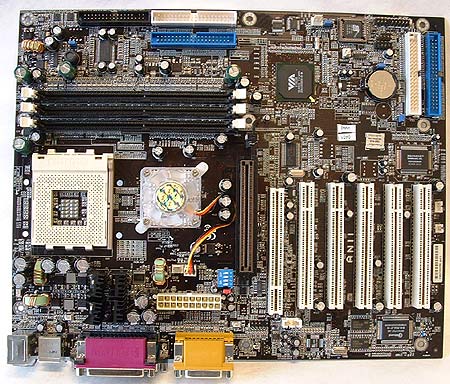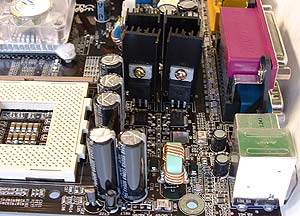FIC AN11 Stealth Socket A Motherboard Review
 First International Computer (FIC) have been producing some pretty good Socket A solutions for a while now and this has helped them improve their penetration into North American retail markets. The company, which was founded in 1980 is better known in Asia where consumers are motivated by value pricing,
and in Europe where their Thin Client computers are more well known. Most North Americans know FIC as a manufacturer of mainboards, but the company also produces webpads, thin clients, notebooks, and barebones systems.
First International Computer (FIC) have been producing some pretty good Socket A solutions for a while now and this has helped them improve their penetration into North American retail markets. The company, which was founded in 1980 is better known in Asia where consumers are motivated by value pricing,
and in Europe where their Thin Client computers are more well known. Most North Americans know FIC as a manufacturer of mainboards, but the company also produces webpads, thin clients, notebooks, and barebones systems.
While you may not be immediately familiar with the link between FIC and VIA, it is
interesting to know that the two companies are joined a the hip so to speak as members of the same family own both companies. FIC's biggest markets are reportedly with system integrators, but we also know their mainboards speak to the value use. With a price tag of just under $100USD the FIC AN11 Stealth comes with a very good set of features, and a very cool all black PCB.
The AN11 Stealth is powered by VIA's much loved KT266A chipset, which practically guarantees that the board is going to be a great performer. What FIC have done to make the Stealth stand out is equip it with 4X AGP, five 32bit PCI's, ACR, onboard audio and IDE RAID. Drop in an AthlonXP, three sticks of DDRAM and you've got the basis of a great system.
| FIC AN11 Stealth Motherboard |
 |
Ships with the following kit:
- 2x IDE ATA66/100 Cable
- FDD Cable
- USB Riser
- Driver CD
- Bundled software: Norton
Antivirus/Firewall/Ghost
- User Manual
|
First impressions of the
Stealth
The black PCB was a rather nice move
from the usual green or brown colour most motherboards natively come with. Since VIA's
KT266A chipset is known to get quite warm during extended use, FIC have chosen an active cooler
with a nifty translucent fan (right away I'm thinking blue LED mod here folks).
The ACR slot is well positioned to give
you an extra 20mm of space in front of the AGP card so
it won't cost you an entire PCI slot if you decide
to mod your graphics card with an extra large cooler. Even if you are not
going the mod route, and most of us won't be, the extra space is always a plus in
terms of air flow and cooling for those precious and very expensive video cards we all crave.
MOSFET's use heatsinks

I was very pleased to see that the MOSFETS on the
AN11 Stealth are cooled by heatsinks rather then by just using the PCB as a
large heatspreading device. Since they are use for the processors power supply,
and do get very hot during use, it's nice to see that FIC has done what they can
to ensure your CPU will get a clean and stable supply of electricity. The
heatsinks are even attached directly to the PCB instead of just remaining free
standing which is another good detail.
Luckily we didn't need to use the clear CMOS jumper
once during testing however it's nice to see it located right next to the CMOS
battery where it is easy to reach.
The floppy drive and IDE harddrive connectors are in the
perfect location, right next to the DIMM slots so they
don't get in the way of expansion card. The onboard IDE RAID connectors are at the bottom
of the motherboard and positioned so as to cause the least amount
of interference to that slot. Ultra/100 IDE RAID comes care of the Promise 20265R
chipset, which can support both RAID's 0 and
1.
RAID 0 is not really considered a true
RAID since there isn't any data redundancy. RAID 0 takes two drives of the same
size/configuration and stripes them, meaning it makes one big drive out of two
equal ones. This improves performance by cutting hard drive latency in half.
Since the data is divided equally and written on two hard drives it also
increases the data bandwidth by two. The reason it's not considered true RAID is
because if one drive fails, all data is lost.
RAID 1 on the other hand mirrors two drives of the same size, so
in theory if one drive fails, the other will take over as the primary hard drive
and the system can continue to operate normally. This is what is supposed to
happen with a SCSI hard drive setup and it actually works pretty well
there.
The IDE subsystem doesn't allow hard
drives to be disconnected while the computer is still powered up and in use like
SCSI can unless you have a special HDD tray. Generally, when one IDE drive fails
the system usually locks up anyway. The data is safe since it's mirrored on the
other drive which is the real benefit.
Up next, a new
feature for PCStats motherboard reviews, Heatsink Clearance Measurements
around the socket!

